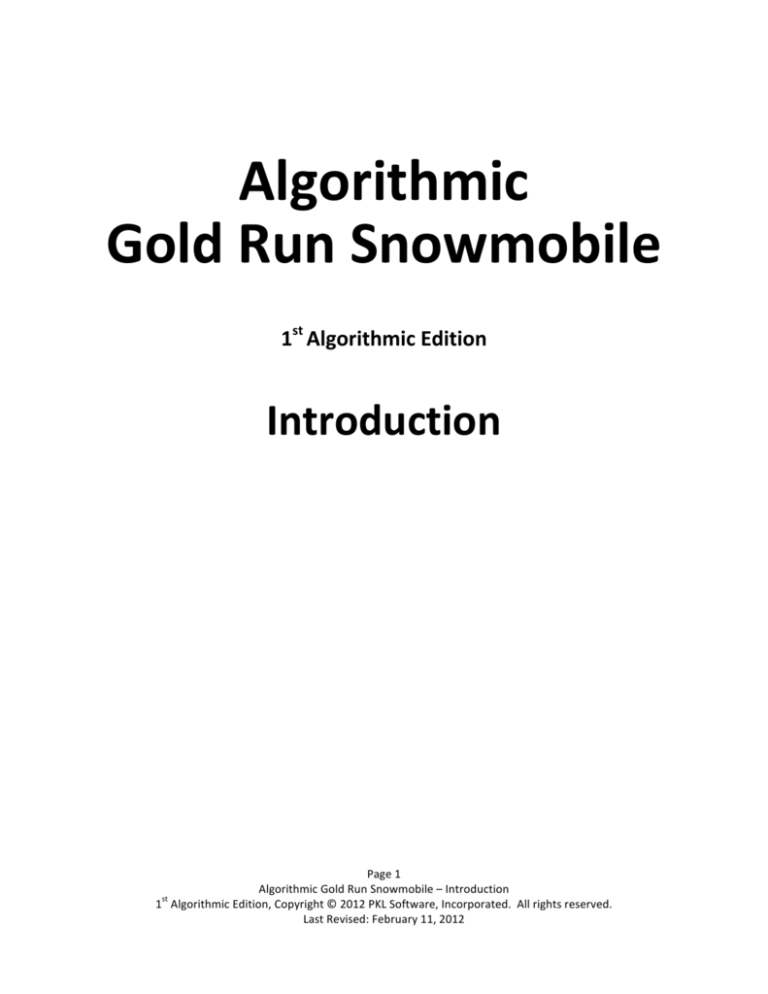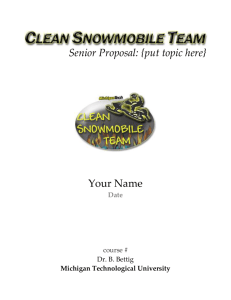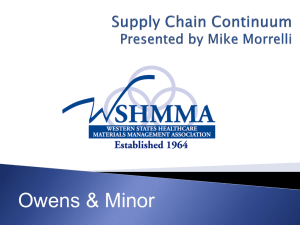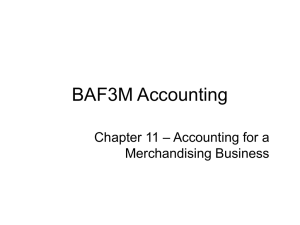
Algorithmic Gold Run Snowmobile 1st Algorithmic Edition Introduction Page 1 Algorithmic Gold Run Snowmobile – Introduction st
1 Algorithmic Edition, Copyright © 2012 PKL Software, Incorporated. All rights reserved. Last Revised: February 11, 2012 An Introduction To Algorithmic GOLD RUN SNOWMOBILE Gold Run Snowmobile is a small corporation, locally owned by several stockholders who are interested in safe snowmobiling as a sport and in the snowmobiling business as a strong business investment. Thomas Sargent and Brenda Maunder, major stockholders in the company, are also salaried executives with full responsibility for its operations. The business, located near Thunder Mountain and Lake Tahoe, is an exclusive dealer for Trail-­‐Tracker Snowmobiles. The business also sells several other brands of snowmobiles and provides excellent service for all snowmobiles, including parts and labor. The business rents storage space to those customers who prefer to keep their snowmobile equipment in the mountains and close to the trails. This practice set, Gold Run Snowmobile, is in algorithmic format. This means that the beginning balances of the ledger accounts, customer and vendor accounts, and inventory accounts are individually developed for each student user and are, therefore, unique balances for each student user. To complete the on-­‐the-­‐job training requirement for your accounting course, you have been placed in a four-­‐week internship program with Gold Run Snowmobile. You will be responsible for all of the accounting work from December 4 through December 31, including recording the transactions, auditing your work, and correcting all errors. Your internship will also require the preparation and printing of the financial statements, analysis of the statements and business operations, and the closing of the books at the end of the fourth quarter, December 31. Since Gold Run Snowmobile uses a computerized accounting system, this opportunity to obtain hands on experience and practice your accounting skills should be very rewarding and exciting. The first step in operating the computerized system correctly is to review the chart of accounts. A clear understanding of how certain accounts are used by Gold Run Snowmobile is required before you begin the recording process. A detailed explanation of how several accounts are used in this accounting system follows on the next five pages. Pages 8, 9 and 10 list the full Chart of Accounts and page 11 displays the Customer List and Vendor List with the account numbers used to identify these customers and businesses when entering the transactions. On pages 12 and 13 is a summary of the special keys that may be used in the data entry process and a review of important business facts that must be remembered when entering the transaction data. Page 2 Algorithmic Gold Run Snowmobile – Introduction st
1 Algorithmic Edition, Copyright © 2012 PKL Software, Incorporated. All rights reserved. Last Revised: February 11, 2012 CHART OF ACCOUNTS To properly enter the accounting transactions for Gold Run Snowmobile, you will need to familiarize yourself with the chart of accounts for the business. The business has four revenue accounts: Snowmobile, Accessories, and Parts Sales; Sales Returns & Allowances; Service Fees Earned; and Storage Fees Earned. The Snowmobile, Accessories, and Parts Sales and Sales Returns and Allowances accounts are used to record all transactions involving the sale and return of merchandise items. Service Fees Earned accounts for fees earned in servicing customer snowmobiles and accessories. Sales tax (7%) is charged on all merchandise and service sales. The revenue account Storage Fees Earned is adjusted at the end of each accounting period to reflect all of the storage fees that have been earned. The liability account, Unearned Storage Fees is used to record all of the initial cash receipts for storage of customer snowmobiles, trailers, and equipment. Sales tax is not charged on storage fees. Gold Run Snowmobile uses a perpetual inventory system. All purchases and sales of merchandise transactions will include additional data entry regarding the quantity and the specific item(s) being purchased or sold. This information will be an automatic part of each journal entry where merchandise is involved. This will maintain a constant updated record of the quantity of all merchandise on hand and the total value of the inventory. Gold Run Snowmobile uses the Net Method to record all purchases of merchandise. All purchases from vendors who extend cash discounts are recorded at the NET cost (the list price less the discount). Example: An inventory item with a $1,200 list price and extended terms of 2/10, n/30 will be recorded as a debit to Merchandise Inventory for $1,176 ($1,200 x .98). All merchandise will be purchased on account and be credited to Accounts Payable. As each purchase invoice is paid on time, Accounts Payable will be debited and Cash credited. On the rare occasion when a purchase invoice that offers a cash discount is, through error, not paid within the discount period, the discount will be lost. This will require a debit to the Discounts Lost account and a credit to the Accounts Payable account. This credit to Accounts Payable will return the balance owed to the vendor to the full balance due (at list prices). This new, corrected balance will then be paid in cash. Under the perpetual inventory system, when any snowmobiles or accessories are sold for cash, on credit, or through customer use of a bank or company credit card, a second entry is required to update the general ledger accounts. This second entry will include a debit to Cost of Goods Sold and a credit to Merchandise Inventory and WILL BE AUTOMATICALLY JOURNALIZED AND POSTED BY THE PROGRAM. Page 3 Algorithmic Gold Run Snowmobile – Introduction st
1 Algorithmic Edition, Copyright © 2012 PKL Software, Incorporated. All rights reserved. Last Revised: February 11, 2012 Gold Run Snowmobile accepts both bank credit cards and company credit cards. When a customer purchases merchandise using a bank credit card, the sale is entered as a cash sale. The credit card expense (1-­‐4%) is not recorded at the time of the sale. For bank card charges the business is charged a credit card fee which is recorded when noted on the bank statement received at the end of the month. If a customer uses a company credit card, the sale is recorded as a sale on account with Accounts Receivable, Credit Card Companies being debited for the charge. This process maintains a record of all of the credit card company charges that are owed to Gold Run Snowmobile, until payment arrives from the credit card company. The credit card expense is recorded when the cash payment is received from the credit card company. Several accounts which require special attention are listed below: 106 Allowance for Doubtful Accounts is the contra current asset account that is debited when accounts receivable are written off as bad debts. 107 Accounts Receivable, Credit Card Companies records all company credit card sales. When the cash is received from the credit card company, the credit card expense is recorded. (All bank card sales are recorded as cash sales with the credit card expense recorded at the end of the month after being charged by the bank.) 111 Storage Fees Receivable is used to record accrued storage fees. 115 Merchandise Inventory is the inventory account for all stocked snowmobiles, accessories, and parts. The perpetual inventory system will maintain a running balance of the Merchandise Inventory account as well as the exact quantity of each product stocked by Gold Run Snowmobile. The correct running balance of this account will be a major check figure given at the end of each week of data entry. 121 Prepaid Insurance is debited for the purchase of all insurance policies. 125 Prepaid Advertising is used only for adjusting entries. All advertising costs are debited directly to the Advertising Expense account. 127 Store and Shop Supplies is debited for all purchases of supplies. 150 Land owned by Gold Run Snowmobile is currently used only as a minor storage facility, but future plans call for construction of a new store and a major storage warehouse. 205 Sales Tax Payable records the 7% sales tax that is charged for all merchandise sales, accessory and parts sales, and service sales. Sales tax is not charged on storage fees. Page 4 Algorithmic Gold Run Snowmobile – Introduction st
1 Algorithmic Edition, Copyright © 2012 PKL Software, Incorporated. All rights reserved. Last Revised: February 11, 2012 221 311 411 421 501 505 602 604 606 Unearned Storage Fees is credited directly for all storage fees received in advance. To keep a storage space, customers are required to pay their fees for at least three months in advance. Sales tax is not charged on storage fees. Dividends Declared is debited for all official dividend declarations. At the end of each accounting period the account is closed to the Retained Earnings account. Service Fees Earned is credited for all customer service and is billed at a rate of $58.00 per hour. Storage Fees Earned is adjusted at the end of the accounting period for all storage fees that have been earned during the quarter. Cost of Goods Sold is the Cost Account that is debited for the cost of each inventory item sold. Under the perpetual inventory system, with each sale of merchandise, Cost of Goods Sold is debited and Merchandise inventory is credited. With each sales return of merchandise, Merchandise is debited and Cost of Goods Sold is credited. As each sale or sales return entry is entered and the merchandise inventory involved is identified, the program will automatically record the entry to update the Cost of Goods Sold and the Merchandise Inventory accounts. Transportation-­‐In is the Cost Account debited for all freight and delivery charges incurred in transporting merchandise to the Gold Run Snowmobile, receiving dock. Most of the shipments of merchandise to Gold Run are with FOB destination terms. The few shipments received with FOB shipping point (FOB factory) terms are charged to the Transportation-­‐In account. The amounts charged to Transportation-­‐In (usually not material) are added to the Cost of Goods Sold when calculating the Gross Profit of the business. Delivery costs for merchandise items sent to customers are charged to the Delivery Expense account. Freight charges for the delivery of assets to the business are charged directly as an additional cost of the asset account. Store and Shop Supplies Expense is used only for adjusting entries. Advertising Expense is debited directly for all advertising fees incurred. Delivery Expense is an Operating Expense Account debited for the delivery and freight charges incurred in shipping merchandise items to customers. Page 5 Algorithmic Gold Run Snowmobile – Introduction st
1 Algorithmic Edition, Copyright © 2012 PKL Software, Incorporated. All rights reserved. Last Revised: February 11, 2012 607 608 622 623 627 628 633 713 721 821 Credit Card Expense accounts for the bank and company credit card fees charged to Gold Run Snowmobile, for allowing customers to use their credit cards to purchase merchandise and services. These fees will be between 1 and 4 percent of the total amount (including sales tax) of the customer charge. Credit card charges for the use of bank cards will be accounted for at the end of the month when listed on the bank statement. Credit card charges for the use of company credit cards will be recorded when the cash is received from the credit card company. An end-­‐of-­‐the-­‐period adjustment will be made at the end of each quarter to account for accrued credit card charges on credit card company receivables that will be collected during the subsequent quarter. Tools Expense is debited for all small purchases of store and shop tools. Insurance Expense is adjusted at the end of each accounting period. Bad Debt Expense is estimated at the end of each quarter using the aging of accounts receivable method. Bank Service Charges is debited for all service costs on the business checking account. License Expense is debited for all business and vehicle license fees. Discounts Lost is charged for the loss incurred when a purchase invoice, through error, is not paid on time (before the end of the discount period). When the NET purchases method is used to record the purchases of merchandise, an internal control system is established to insure that all invoices are paid in time to qualify for the discount. The Discounts Lost account should never have an entry if the Gold Run Snowmobile control system is in place and used properly. Dividends Earned is an Other Revenue Account that is credited for dividends earned on short-­‐term investments. Gain on Sale of Assets is an Other Revenue Account that is credited when the proceeds from the sale of a Plant and Equipment asset are greater than the book value of the asset. This account is not used in like-­‐kind exchange (trade) transactions. Loss on Sale/Disposal of Assets is an Other Expense Account that is debited when a Plant and Equipment asset is sold and the proceeds of the sale are less than the book value of the asset. This account is also used to account for the loss incurred when an asset with book value is donated or given away. For like-­‐kind exchange (trade) transactions, this account is used when the trade-­‐in allowance granted is less than the book value of the asset being traded. Page 6 Algorithmic Gold Run Snowmobile – Introduction st
1 Algorithmic Edition, Copyright © 2012 PKL Software, Incorporated. All rights reserved. Last Revised: February 11, 2012 When entering the transactions in the Gold Run Snowmobile accounting system, all of the accounts will be identified by account number. You will see the account title appear on the screen after you enter the account number. With the cursor at the account prompt, the Chart of Accounts may be displayed on the screen by clicking on the Chart of Accounts drop down menu. You may move through the chart using the scroll bar or print it for future reference. Special data entry procedures that will make your work very efficient have been built into the new Gold Run Snowmobile accounting system. These procedures will be introduced and explained in detail in the first few entries that you journalize for December 4, 5, and 6. Detailed information on customer and vendor account activity and account balances will be maintained automatically in the Accounts Receivable and the Accounts Payable ledgers. Information will be recorded in the system by identifying each customer or vendor/creditor by number. All inventory activity will be recorded on and entry by entry basis, maintaining a complete up-­‐
to-­‐date record of all inventory items. Page 7 Algorithmic Gold Run Snowmobile – Introduction st
1 Algorithmic Edition, Copyright © 2012 PKL Software, Incorporated. All rights reserved. Last Revised: February 11, 2012 GOLD RUN SNOWMOBILE, INCORPORATED CHART OF ACCOUNTS 101 102 103 105 106 107 109 111 113 115 121 124 125 127 131 132 135 136 139 140 150 201 203 204 205 207 209 211 213 215 221 231 ASSETS Cash Petty Cash Short-­‐Term Investments Accounts Receivable Allowances for Doubtful Accounts Accounts Receivable, Credit Card Companies Notes Receivable Storage Fees Receivable Interest Receivable Merchandise Inventory Prepaid Insurance Prepaid Property Tax Prepaid Advertising Store and Shop Supplies Store Equipment Accumulated Depreciation, Store Equipment Shop Equipment Accumulated Depreciation, Shop Equipment Trucks Accumulated Depreciation, Trucks Land LIABILITIES Accounts Payable Notes Payable Discount on Notes Payable Sales Tax Payable Dividends Payable Salaries & Wages Payable Estimated Property Taxes Payable Income Taxes Payable Interest Payable Unearned Storage Fees Long-­‐Term Lease Liability Page 8 Algorithmic Gold Run Snowmobile – Introduction st
1 Algorithmic Edition, Copyright © 2012 PKL Software, Incorporated. All rights reserved. Last Revised: February 11, 2012 GOLD RUN SNOWMOBILE, INCORPORATED CHART OF ACCOUNTS 301 305 311 401 402 411 421 501 505 601 602 603 604 606 607 608 610 611 612 STOCKHOLDERS’ EQUITY Common Stock Retained Earnings Dividends Declared REVENUE Snowmobile and Accessories Sales Sales Returns and Allowances Service Fees Earned Storage Fees Earned COST OF GOODS SOLD Cost of Goods Sold Transportation-­‐In OPERATING EXPENSES Store and Shop Expenses Salaries and Wages Expense Store and Shop Supplies Expense Truck and Equipment Operating Expense Advertising Expense Delivery Expense Credit Card Expense Tools Expense Depreciation Expense, Store Equipment Depreciation Expense, Shop Equipment Depreciation Expense, Trucks Page 9 Algorithmic Gold Run Snowmobile – Introduction st
1 Algorithmic Edition, Copyright © 2012 PKL Software, Incorporated. All rights reserved. Last Revised: February 11, 2012 GOLD RUN SNOWMOBILE, INCORPORATED CHART OF ACCOUNTS 621 622 623 624 625 626 627 628 629 631 633 635 711 713 721 731 741 811 813 821 831 901 Administrative Expenses Rent Expense Insurance Expense Bad Debt Expense Property Tax Expense Electric and Gas Expense Telephone Expense Bank Service Charges License Expense Professional Services Expense Cash Short and Over Discounts Lost Miscellaneous Expense OTHER REVENUE Interest Earned Dividends Earned Gain on Sale of Assets Gain on Short-­‐Term Investments Miscellaneous Revenue OTHER EXPENSES Income Tax Expense Interest Expense Loss on Sale/Disposal of Assets Loss on Short-­‐Term Investments INCOME SUMMARY Income Summary Page 10 Algorithmic Gold Run Snowmobile – Introduction st
1 Algorithmic Edition, Copyright © 2012 PKL Software, Incorporated. All rights reserved. Last Revised: February 11, 2012 GOLD RUN SNOWMOBILE, INCORPORATED CUSTOMER LIST Customer Number 10400 10450 10750 10930 11000 11250 11340 11470 11510 11675 11780 11800 11925 11950 Customer Mary Bermuda Colfax Sno Katts Alice Cordero Downieville Dusters Chris Enburger Cathi Grobowski Beverly Kline Ray Norburg Karen Osetto Cheryl Papini Running Ramblers Snowbirds Thunder Mountain, Inc. Ruth Yates GOLD RUN SNOWMOBILE, INCORPORATED VENDOR LIST Vendor Number 20300 21680 22500 23400 24850 26500 27000 28400 29650 Vendor Buster Supply Butler & Kadnaso Fastwinn, Incorporated Inglass, Incorporated Morelli Sports Equipment Norton America Swift, Incorporated Trail-­‐Tracker, Inc. Wind Dancer Page 11 Algorithmic Gold Run Snowmobile – Introduction st
1 Algorithmic Edition, Copyright © 2012 PKL Software, Incorporated. All rights reserved. Last Revised: February 11, 2012 KEY DETAILS TO REMEMBER AS YOU JOURNALIZE TRANSACTIONS! To properly and efficiently operate the computerized accounting system used by Gold Run Snowmobile, you must be familiar with several important computer procedures as well as business and account information details. These procedures and details are summarized in the list below: Sales tax of 7% is charged on all sales and labor. Sales tax is not charged on storage fees. When calculating sales tax, round all amounts to the nearest cent ($4.025768 = $4.03). Credit Card Fees of 1% to 4% will be assessed by banks and credit card companies. Bank credit card fees will be accounted for at the end of the month from information received on the bank statement. Credit card company fees will be recorded when the net cash amount is received from the credit card company. Labor charges will be billed to customers at a rate of $58.00 per hour. Where necessary, round all calculations to the nearest cent. For all interest calculations use exact days and a 360-­‐day banker's year. For all interest and discount calculations, round the interest or discount amount to the nearest cent. All sales or sales returns of merchandise items will require two entries. After the regular sales or sales return entry has been recorded and posted, the program will automatically record the second entry required with an update to the Cost of Goods Sold and the Merchandise Inventory accounts. Inventory information is entered into the system for any journal entry that changes the quantity/value of the Merchandise Inventory account. When a journal entry for any sales, sales return, merchandise purchase, or merchandise return transaction is verified, the inventory information is then requested. When the inventory information matches the journal entry, click on Post and the general ledger, subsidiary ledger, and the inventory ledger will be updated. The NET method is used to record all merchandise purchases. It is intended that all invoices be paid on time. If an error is made and an invoice is not paid on time, the cost of this error will be recorded in the Discounts Lost account. All personal snowmobiles and snowmobile trailers carry a 25% markup on net cost (20% markup on selling price). All accessories carry a 100% markup on net cost (50% markup on selling price). Example: A snowmobile with a net cost of $5,000 would sell at retail for $6,250 ($5,000 x 1.25). An accessory with a net cost of $4.50 would sell at retail for $9.00. Page 12 Algorithmic Gold Run Snowmobile – Introduction st
1 Algorithmic Edition, Copyright © 2012 PKL Software, Incorporated. All rights reserved. Last Revised: February 11, 2012 Gold Run Snowmobile extends 30-­‐day credit to all charge customers. Balances that are over the 30-­‐day credit period are considered past due. When entering transactions, always use proper accounting procedure and enter the debit entries first. When debited dollar amounts equal the credited dollar amounts you will have a complete transaction to verify. If an error correction entry for cash requires a credit to cash and a check has not been issued, enter ERROR as the check number. An ERROR CORRECTION ENTRY with a credit to the Merchandise Inventory account will request a debit memo number. At the debit memo prompt enter ERROR. You may terminate a journalizing session at any time. When you return to the journal entry process at a later time, the last entry recorded and posted will be displayed on the screen. A beginning December 3, Trial Balance, Schedule of Accounts Receivable, Schedule of Accounts Payable, and an Inventory Analysis form can be printed at the beginning of this set before you begin your data entry. Page 13 Algorithmic Gold Run Snowmobile – Introduction st
1 Algorithmic Edition, Copyright © 2012 PKL Software, Incorporated. All rights reserved. Last Revised: February 11, 2012





